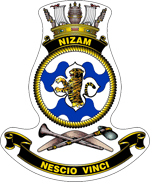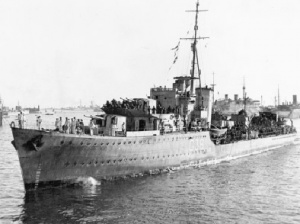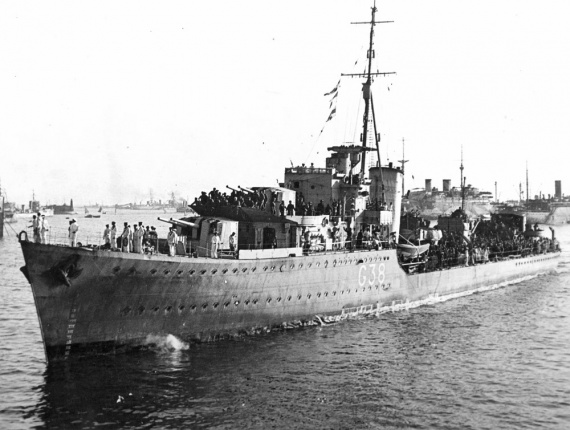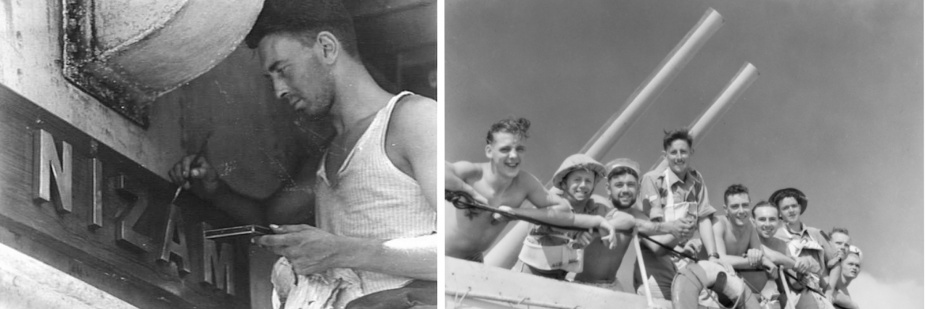HMAS Nizam
| Class |
N Class |
|---|---|
| Type |
Destroyer |
| Pennant |
G38 |
| Builder |
John Brown and Co Ltd, Clydebank, Scotland |
| Laid Down |
27 July 1939 |
| Commissioned |
19 December 1940 |
| Decommissioned |
17 October 1945 |
| Dimensions & Displacement | |
| Displacement |
|
| Length | 356 feet 6 inches |
| Beam | 35 feet 8 inches |
| Draught | 16 feet 4 inches (maximum) |
| Performance | |
| Speed | 36 knots |
| Complement | |
| Crew | 226 |
| Propulsion | |
| Machinery | Parsons geared turbines |
| Horsepower | 40,000 |
| Armament | |
| Guns |
|
| Torpedoes | 10 x 21-inch torpedo tubes (2 pentad mounts) |
| Other Armament |
|
| Awards | |
| Battle Honours | |

HMAS Nizam was one of eight N Class destroyers laid down in British yards during 1939 to the order of the Royal Navy. Five (Napier, Nestor, Nepal, Nizam and Norman (I)) were transferred to the Royal Australian Navy, two to the Royal Netherlands Navy and one to the Polish Navy. The only one to become a war loss, HMAS Nestor, was sunk by air attack in the Mediterranean on 16 June 1942.
Nizam commissioned on 19 December 1940 under the command of Lieutenant Commander Max J Clark RAN.
After trials at Greenock, Nizam was employed in fleet duties at Scapa, followed by convoy escort work in the North Atlantic between January and March 1941. In April 1941 Nizam escorted a convoy to Gibraltar, proceeding on south to Freetown, then to St Helena, Capetown and Durban, then back to the Mediterranean via Mombassa, Aden and Suez. During the passage in the Red Sea, Nizam carried out a sweep ahead of the transports Queen Mary and Queen Elizabeth which were carrying Australian troops to the Middle East.
Arriving at Alexandria on 4 May 1941, Nizam's next task was to screen, with the Battle Fleet, the movement of Queen Elizabeth from the Western Mediterranean to Alexandria.
On 21 May 1941 Nizam, in company with destroyers HM Ships Ilex, Jervis and Havock, carried out a bombardment of Scarpanto, then followed the embarkation of commandos at Alexandria for passage to Crete. The commandos were duly landed on the second attempt at Suda Bay and wounded and base troops embarked for return to Alexandria. This work was carried out under continuous German bombing and on the return trip further heavy bombing attacks were experienced.
Then followed two ferry trips from Crete to Alexandria to evacuating troops from Crete, during which the ships were subject to continuous bombing from within a radius of 250 miles of Crete. On her final trip Nizam embarked 698 troops and her sister ship HMAS Napier brought back 705 troops, the majority of whom were Australians.
Nizam then made a run to Tobruk and back to Alexandria, followed by a period of three weeks off the Syrian coast bombarding Vichy French positions. During this period Nizam, in company with HM Ships Naiad, Phoebe, Jaguar and Kingston, was in action in Beirut Bay with two Vichy destroyers which escaped, though severely damaged. The date was 23 June 1941. Following the Syrian campaign, Nizam went on the Tobruk Ferry run, making altogether 14 trips.
On 14 August 1941, while entering Tobruk at night, Nizam collided heavily with a wreck in the harbour and damaged her bow. On 17 September 1941 Nizam was near missed by a bomb while leaving Tobruk harbour and her oil fuel pumps were damaged. She was taken in tow by HMS Kingston and got clear of the area, then managed to repair the damage and return to Alexandria where she was docked for repairs.
During October and November 1941 Nizam took her place as part of a screening force for Malta convoys, and during this period took part in the bombardments of Sollum and Bardia. Nizam was present at the time HMS Barham was torpedoed and sunk on 25 November 1941 and rescued many survivors, taking them to Alexandria.
Nine destroyers, including Nizam, were then employed off the Syrian coast transferring 30,000 troops (15,000 each day) from Famagusta in Cyprus to Haifa and vice-versa. British troops at Cyprus were replaced by Indian troops, the operation taking five days.
In December 1941 Nizam was one of the screen of a powerful force, including heavy ships, taking the special ship SS Breconshire from Alexandria to Malta. The Italian Battle Fleet was at sea and a clash was an anticipated, but the Italians retired.
In January 1942 Nizam, Napier and Nestor left the Mediterranean for Singapore. On reaching Aden they were detached, with Nestor escorting the aircraft carrier HMS Indomitable carrying Hurricane fighters to Java. This force proceeded to Java and within sight of the island the aircraft were flown off to land in Java.
From this duty, Nizam and her consorts joined the Eastern Fleet at Trincomalee. Nizam then spent five weeks in dock at Bombay. By way of the Seychelles, Nizam then joined the Eastern Fleet stationed at Mombassa. In February and March 1942 she was on convoy escort duty during which one of her tasks was screening for five days from Trincomalee the first batch of AIF troops returning from the Middle East to Australia.
Late in March 1942 Nizam, Napier, Nestor and Norman (I) took part in the large scale Indian Ocean sweep carried out by the Eastern Fleet in operations against Japanese naval forces known to be at sea. No action resulted. After a visit to Bombay and return to Mombassa, Nizam and Napier returned to the Mediterranean, where they were joined by Norman (I) and Nestor at Haifa to form part of the screening force for a large convoy sailing from Alexandria to Malta convoy in June 1942. Nestor was lost during these operations.
The next interesting event in Nizam's war service was her participation in the Madagascar campaign in September 1942. Diego Suarez had already fallen when the N Class destroyers arrived. They were immediately attached to a convoy which was formed to attack the west coast of the island. On 10 September the town of Majunga surrendered and Nizam then proceeded with the assault ships to Tamatave, which surrendered on 18 September. On 18 September Nizam and HMS Hotspur, en route to Durban, intercepted and captured the Vichy French merchant ship Marshall Galleni which had escaped from Madagascar and took her to Durban. Two days later Nizam and Hotspur chased another Vichy ship, the Antral Pierre, but this vessel opened her sea cocks and could not be salvaged.
Proceeding to Simonstown, Nizam was taken in hand for a refit, three months having lapsed since the last boiler clean. It was estimated that in this period she had steamed for approximately 1,450 hours. This refit was not completed until 28 December 1942.
In January 1943 Commander CH Brooks RAN, relieved Commander MJ Clark DSO RAN, as Commanding Officer of Nizam. The ship arrived at Kilindini on 4 January 1943 and her next operation was a sweep into the Indian Ocean in February, with part of the Eastern Fleet which included HM Ships Warspite, Revenge, Resolution and cruisers.
From then on, Nizam carried out fleet destroyer and convoy escort duties until July 1943. On 13 July she rescued survivors of the MV Sebastion Cermano, and on the 31st rescued survivors from the Cornish City, both ships having been sunk by enemy submarines operating in the area. At this time the enemy was carrying out a concentrated attack on shipping in the Cape area and Nizam, together with eight other destroyers, was operating on the South Atlantic Station on shipping protection duties.
On 26 July 1943 Nizam sailed from Durban for Australia via Diego Garcia. She arrived at Geraldton on 13 August and then proceeded to Melbourne for refit. She completed her refit in mid-October and, after completing sea trials, sailed to Fremantle arriving there at the end of October. During 4-17 November she escorted Convoy OW 7 from Geraldton to Colombo and in November 1943 Nizam joined the Eastern Fleet at Kilindini, but in December was away on convoy duty to Aden.
On 27 January 1944 Napier and Nizam rejoined the Eastern Fleet en route to the re-opened Fleet Base at Trincomalee, arriving on 6 February 1944. On 8 March the fleet departed for operations in the Bay of Bengal and on 19 April 1944 the Australian destroyers participated in the Eastern Fleet carrier strike on the Japanese held port of Sabang in Sumatra. The Australian destroyers were HMA Ships Napier, Nepal, Nizam, Quiberon and Quickmatch.
From May until November 1944 Nizam was employed on shipping protection duties in the Indian Ocean. In November she returned to Melbourne for refit. By September 1944 Britain's strongest fleet was based on Ceylon, and was still known as the British Eastern Fleet.
In November 1944 the British Pacific Fleet was formed, and ships allocated to this new formation prepared to leave for the Pacific theatre of operations. In January 1945 the British Pacific Fleet carrier force en route from Ceylon to Sydney, struck Palembang in Sumatra and stopped oil production in the area.
Nizam was under refit in Melbourne from 3 November 1944 to 31 January 1945. On 1 February 1945 Lieutenant Commander WF Cook RAN assumed command, and after trials in Port Phillip Bay, Nizam proceeded to Fremantle on 9 February. On 11 February in a position twelve miles off Cape Leeuwin Light and while altering course, the ship struck a freak wave and rolled very heavily, 75 to 80 degrees, to port and 10 ratings were lost overboard. This accident occurred at ten o'clock at night with the wind at nearly gale force. The ship circled for a long period but no sign of any survivor was seen. Some damage was caused and Nizam remained at Fremantle until 7 March 1945 making good defects.
On 14 March 1945 Nizam reached Sydney, where she joined the remainder of the N Class destroyers, Napier, Nepal and Norman (I). On 1 April Napier, Norman (I) and Nizam proceeded in company for Manus Island, arriving on 7 April. On 13 April Norman and Nizam arrived at Leyte Gulf and became part of the British Pacific Fleet.
On 25 April sickness diagnosed as Poliomyelitis broke out aboard Nizam and the ship was placed in quarantine and pronounced unfit for operational service. In May 1945 Nizam was permitted to proceed with the Logistic Support Group for Task Force 57, operating against the Japanese home islands and proceeded into the Service area. On 18 May this group returned to Leyte and on 23 May Nizam proceeded to Manus Island en route for Sydney, where she arrived on 4 June. After further repairs to machinery Nizam sailed for Manus via Milne Bay on 28 June 1945 and arrived on 4 July.
On 9 July Nizam joined Napier and HM Ships Striker, Arbiter and Glenarthney, forming Task Unit 112.2.6, and proceeded to the Service area. On 19 July this force was joined by HMS Indefatigable, escorted by the destroyers HM Ships Wrangler and Wakeful, and on 20 July rendezvoused with Task Unit 57. Striker was the light carrier which supplied the main fleet carriers with aircraft for the assault on Japan. After replenishment was made, escorted Striker back to Manus, arriving on 27 July.
On 1 August 1945, escorting Arbiter, was proceeding to rendezvous with Task Force 37 in the vicinity of Saipan. On 2 August investigated the Japanese hospital ship Kiru Maru bound from Yokosuka to Marcus Island - the hospital ship was permitted to proceed.
Nizam joined Task Force 37 on 7 August and proceeded to the operational area off Japan, in company with the United States Third Fleet. Air Strikes were flown off on 9 and 10 August. No opposition was encountered. At 10:40 on 12 August, news was received of the Japanese decision to accept the Surrender Terms. The strikes scheduled for this day were cancelled.
Strikes against the Tokyo area were continued on 13 August. acted as escort destroyer to Indefatigable. On 15 August 1945 the Commander-in-Chief Pacific cancelled all offensive operations; at 11:20 the signals 'Cease hostilities against Japan' and 'Splice the Mainbrace' were received by flag hoist. As these signals were flying an enemy aircraft, intercepted by fighter cover, was shot down about two cables off the port beam.
The British landing force, which included two officers and 19 ratings from Nizam, was transferred to USS Sims on 20 August 1945. Task Force 37 moved into Tokyo Bay on 27 August where Nizam met HMA Ships Shropshire, Hobart (I), Warramunga (I) and Bataan.
On 2 September 1945 when the surrender was signed aboard USS Missouri in Tokyo Bay, Nizam was duty destroyer in Tokyo Bay and made several trips with recovered Allied military personnel.
On 12 September Nizam sailed with HMNZS Gambia for detached duty with the United States Fifth Fleet at Wakayama. On 14 September Nizam sent a reception party to meet a large party of Australian recovered prisoners of war - among the party were four ratings who were survivors from HMAS Perth (I). A typhoon was experienced on the afternoon of 17 September which Nizam rode out successfully, at times rolling 30 degrees each way.
On 19 September Gambia and Nizam rejoined Task Force 37 at Tokyo. On 24 September Nizam was released for return to Australia. She took passage via Guam, Manus and Jomard Passage and reached Sydney at 10:00 on 5 October 1945.
On 17 October 1945 Nizam's commission in the Royal Australian Navy came to an end. She paid off and on the same day recommissioned as HMS Nizam. Her complement transferred to HMAS Quadrant and the Royal Navy complement from that ship manned Nizam for return to England. Nizam was scrapped in 1956. The total distance steamed by Nizam on war service was 295,206 miles.
Further reading
'Man Overboard! The HMAS Nizam Tragedy' by Andrew Rose and Sandra Rose - published by Red Rose Books, Western Australia, 2006.








